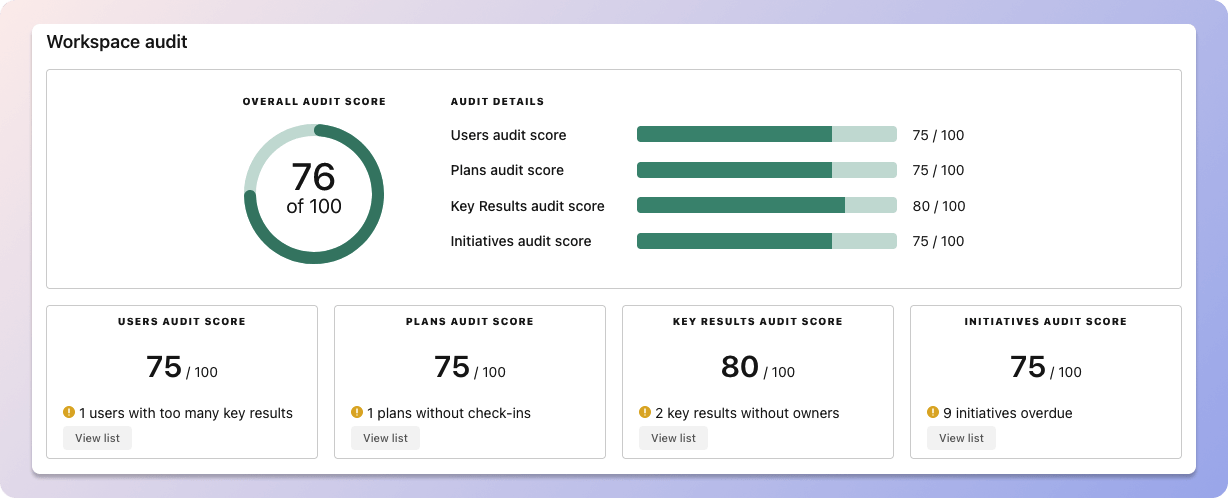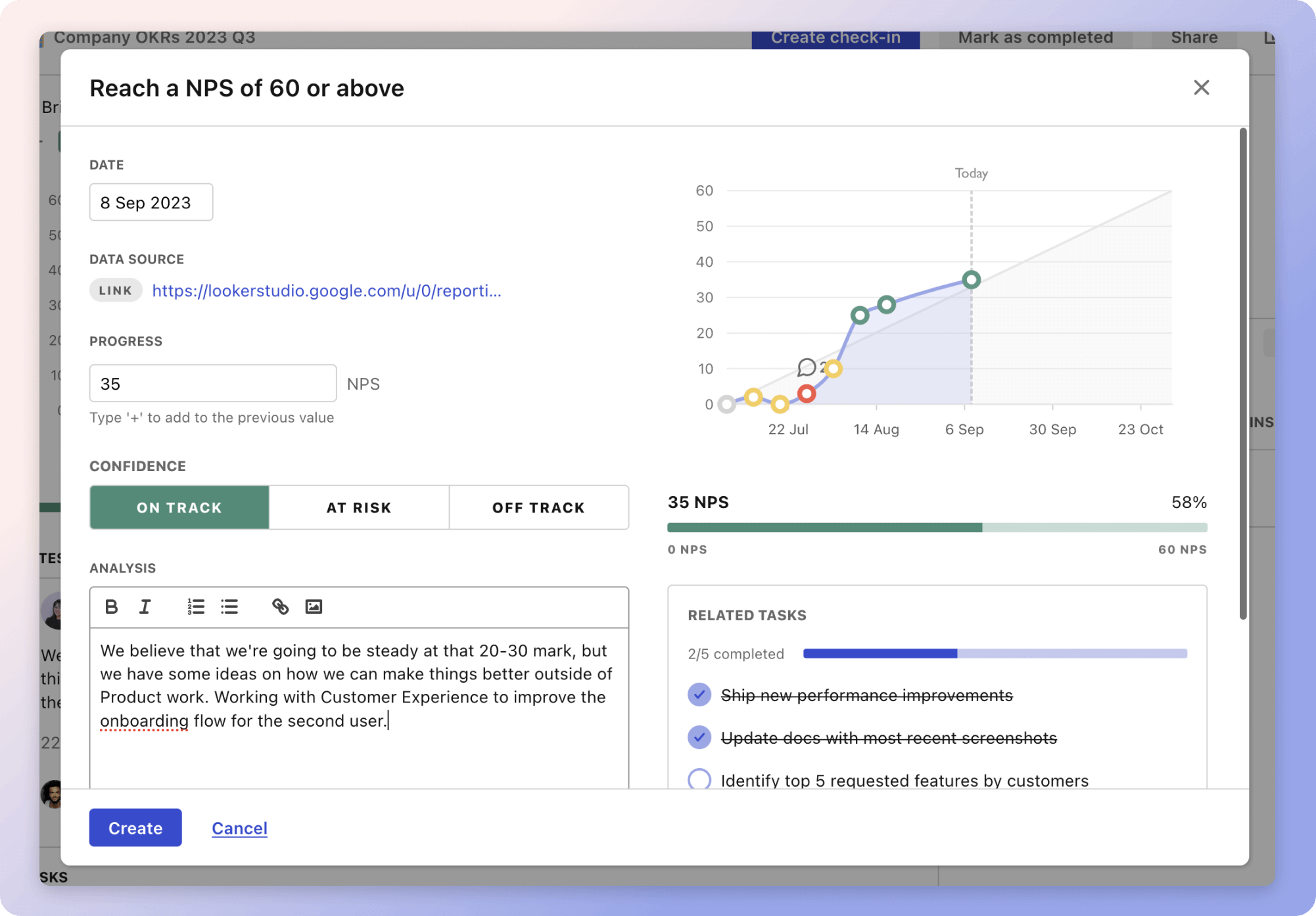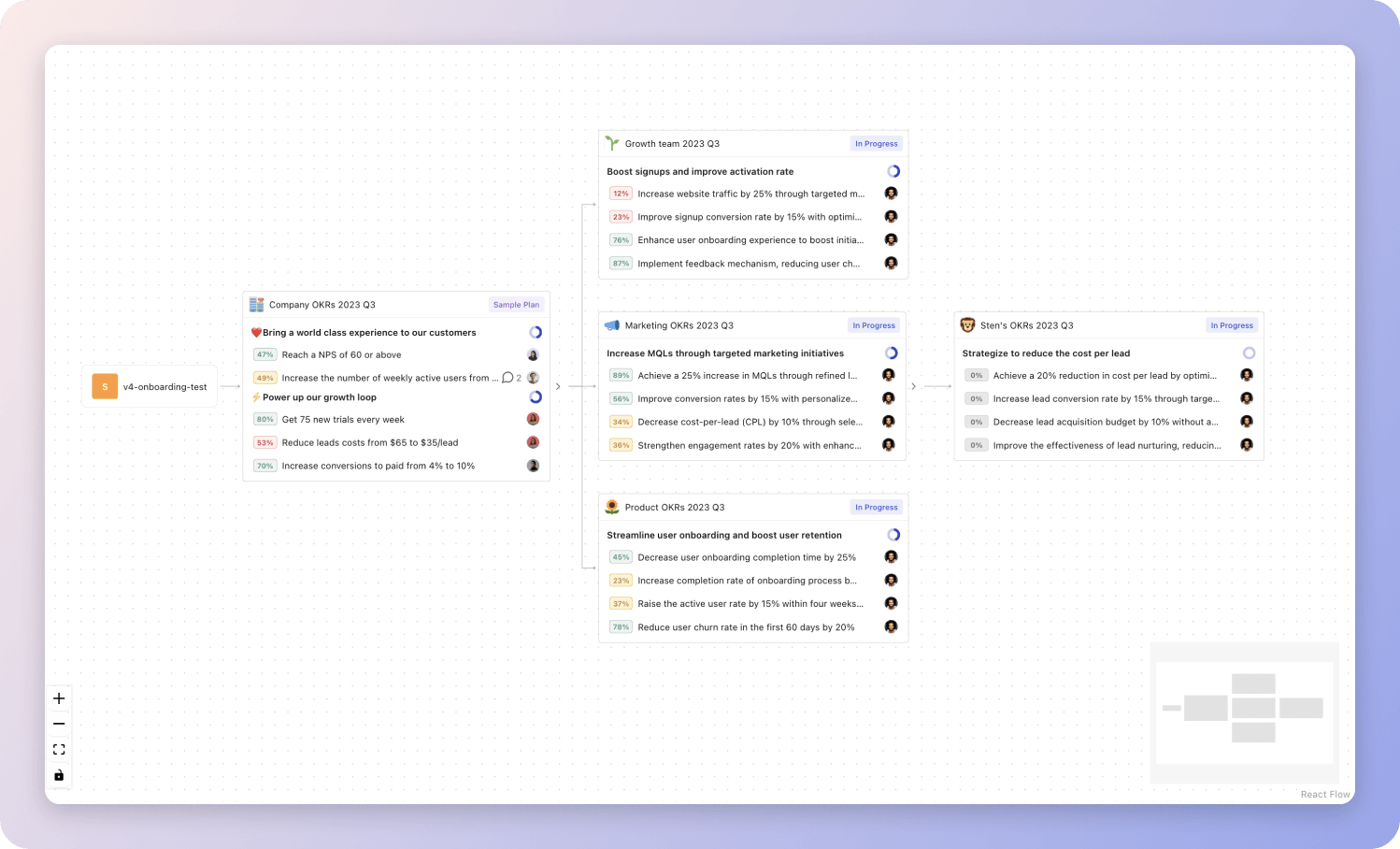4 OKR examples for Okrs
What are Okrs OKRs?
The Objective and Key Results (OKR) framework is a simple goal-setting methodology that was introduced at Intel by Andy Grove in the 70s. It became popular after John Doerr introduced it to Google in the 90s, and it's now used by teams of all sizes to set and track ambitious goals at scale.
How you write your OKRs can make a huge difference on the impact that your team will have at the end of the quarter. But, it's not always easy to write a quarterly plan that focuses on outcomes instead of projects.
We have curated a selection of OKR examples specifically for Okrs to assist you. Feel free to explore the templates below for inspiration in setting your own goals.
If you want to learn more about the framework, you can read more about the OKR meaning online.
Best practices for managing your Okrs OKRs
Generally speaking, your objectives should be ambitious yet achievable, and your key results should be measurable and time-bound (using the SMART framework can be helpful). It is also recommended to list strategic initiatives under your key results, as it'll help you avoid the common mistake of listing projects in your KRs.
Here are a couple of best practices extracted from our OKR implementation guide 👇
Tip #1: Limit the number of key results
Focus can only be achieve by limiting the number of competing priorities. It is crucial that you take the time to identify where you need to move the needle, and avoid adding business-as-usual activities to your OKRs.
We recommend having 3-4 objectives, and 3-4 key results per objective. A platform like Tability can run audits on your data to help you identify the plans that have too many goals.
 Tability's audit dashboard will highlight opportunities to improve OKRs
Tability's audit dashboard will highlight opportunities to improve OKRsTip #2: Commit to the weekly check-ins
Having good goals is only half the effort. You'll get significant more value from your OKRs if you commit to a weekly check-in process.
Being able to see trends for your key results will also keep yourself honest.
 Tability's check-ins will save you hours and increase transparency
Tability's check-ins will save you hours and increase transparencyTip #3: No more than 2 yellow statuses in a row
Yes, this is another tip for goal-tracking instead of goal-setting (but you'll get plenty of OKR examples below). But, once you have your goals defined, it will be your ability to keep the right sense of urgency that will make the difference.
As a rule of thumb, it's best to avoid having more than 2 yellow/at risk statuses in a row.
Make a call on the 3rd update. You should be either back on track, or off track. This sounds harsh but it's the best way to signal risks early enough to fix things.
Building your own Okrs OKRs with AI
While we have some examples below, it's likely that you'll have specific scenarios that aren't covered here. There are 2 options available to you.
- Use our free OKRs generator
- Use Tability, a complete platform to set and track OKRs and initiatives
- including a GPT-4 powered goal generator
Best way to track your Okrs OKRs
OKRs without regular progress updates are just KPIs. You'll need to update progress on your OKRs every week to get the full benefits from the framework. Reviewing progress periodically has several advantages:
- It brings the goals back to the top of the mind
- It will highlight poorly set OKRs
- It will surface execution risks
- It improves transparency and accountability
We recommend using a spreadsheet for your first OKRs cycle. You'll need to get familiar with the scoring and tracking first. Then, you can scale your OKRs process by using a proper OKR-tracking tool for it.
 Tability's Strategy Map makes it easy to see all your org's OKRs
Tability's Strategy Map makes it easy to see all your org's OKRsIf you're not yet set on a tool, you can check out the 5 best OKR tracking templates guide to find the best way to monitor progress during the quarter.
Okrs OKRs templates
We've covered most of the things that you need to know about setting good OKRs and tracking them effectively. It's now time to give you a series of templates that you can use for inspiration!
You'll find below a list of Objectives and Key Results templates for Okrs. We also included strategic projects for each template to make it easier to understand the difference between key results and projects.
Hope you'll find this helpful!
OKRs to improve understanding of OKRs
Improve understanding of OKRs
Read at least two books or articles about OKRs to deepen understanding
Research top books on OKRs and make a list of two to read
Set aside dedicated time every week to read and focus on OKR materials
Discuss key takeaways with colleagues or mentors to enhance comprehension
Take notes while reading to summarize main concepts and ideas
Attend a training session on OKRs to gain foundational knowledge
Attend and actively participate in the OKR training session
Prepare a notebook or document to take notes during the training session
Research online for a reputable training session on OKRs
Register for the chosen training session on OKRs
Create and successfully implement a personal OKR to apply knowledge gained
Discuss OKRs with at least three colleagues to gather different perspectives
Engage actively in conversations with colleagues to understand their perspectives
Take notes during discussions to capture different insights on OKRs
Schedule a meeting with colleagues to discuss OKRs
Prepare a list of questions to prompt discussion on OKRs
OKRs to effectively craft and define OKR for strategic clarity
Effectively craft and define OKR for strategic clarity
Develop engaging, SMART, and unique KRs for each department
Gather insights on specific objectives for each department
Craft unique, measurable KRs aligned with these objectives
Facilitate workshops for SMART KR development and engagement
Conduct training sessions on OKR interpretation and implementation for all team leads
Evaluate and refine training impact periodically
Develop comprehensive OKR interpretation and implementation curriculum
Schedule regular training sessions for team leads
Establish a monitoring process to track the progress of all OKRs
Identify and assign team members responsible for monitoring each OKR progress
Determine key metrics to measure progress of all OKRs
Implement a tracking system to consistently record OKR data
OKRs to get started with OKRs
Be obsessive about the customers
Do 50 interviews with existing users
Increase NPS from 25 to 50
Reduce churn from 6% to 2%
Create an efficient growth engine
Grow MRR from $100k to 130k
Increase the number of customers from 200 to 260
Reduce the CAC Payback Period from 14 months to 9 months
Build a team of all-stars
Grow the team from 7 to 12
Increase employee NPS from 50 to 70
OKRs to optimize Trello Board for effective team OKR management
Optimize Trello Board for effective team OKR management
Conduct 5 training sessions on Trello usage to increase team efficiency by 20%
Create a comprehensive Trello training curriculum
Schedule and conduct five Trello training sessions
Identify Trello features that boost team efficiency
Ensure 100% of team updates their respective OKRs on Trello weekly
Issue weekly reminder emails to update OKRs on Trello
Give a short training on updating OKRs on Trello
Implement OKRs review during team meetings
Improve Trello Board navigation efficiency by 30% through reorganization and streamlining
Train team on navigation improvements to ensure smoother usage
Implement an intuitive, uniform labeling system across all boards
Review all current Trello boards for possible streamlining opportunities
More Okrs OKR templates
We have more templates to help you draft your team goals and OKRs.
OKRs to generate significant growth through Content Marketing
OKRs to develop a unified platform for third-party data delivery to mobile apps
OKRs to transform company with lean and agile focus
OKRs to optimize financial operations for strategic partnerships and alliances
OKRs to increase job productivity through effective goal setting and time management
OKRs to enhance overall website traffic
OKRs resources
Here are a list of resources to help you adopt the Objectives and Key Results framework.
- To learn: Complete 2024 OKR cheat sheet
- Blog posts: ODT Blog
- Success metrics: KPIs examples